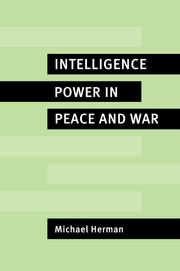Book contents
- Frontmatter
- Contents
- List of figures
- Preface and acknowledgements
- Glossary of terms and abbreviations
- Introduction
- I Evolution and outline
- II Components and boundaries
- 4 Collection sources
- 5 Collection characteristics
- 6 All-source analysis and assessment
- 7 Boundaries
- III Effects
- IV Accuracy
- V Evaluation and management
- VI The 1990s and beyond
- VII Summary
- Suggestions for further reading
- Index
5 - Collection characteristics
Published online by Cambridge University Press: 27 October 2009
- Frontmatter
- Contents
- List of figures
- Preface and acknowledgements
- Glossary of terms and abbreviations
- Introduction
- I Evolution and outline
- II Components and boundaries
- 4 Collection sources
- 5 Collection characteristics
- 6 All-source analysis and assessment
- 7 Boundaries
- III Effects
- IV Accuracy
- V Evaluation and management
- VI The 1990s and beyond
- VII Summary
- Suggestions for further reading
- Index
Summary
Observations and messages
In the collection just described there are some regular associations between sources and subjects. Imagery's output is mainly defence intelligence, including arms production and details of road and rail communications and the rest of the military infrastructure. Sigint produces something on almost everything, though during the Cold War its main output in bulk was on day-to-day Soviet military activities. Humint agencies produce less military material and more on political and economic matters, plus special contributions on other states' clandestine activities and on terrorism. The smaller technical sources are all defence-related, as are those associated with the battlefield. Peacetime surveillance and observation are characteristic of security intelligence.
These associations illustrate a distinction between two basic kinds of collection. One produces evidence in the form of observations and measurements of things. The other produces access to human thought-processes, or meaning. The distinction resembles the difference between the evidence used in archaeology and conventional historiography. Archaeology deals in artefacts and physical traces, while historians base themselves on documents and other human recollections. Both kinds of evidence contribute to historical truth, but with answers to different kinds of question. Inferences from archaeological observation and measurement are not the same as from documents or oral records.
Thus imagery produces the kind of evidence used by archaeologists (who indeed now use aerial photography); while Humint and Sigint have the ability to produce texts not unlike those used by historians.
- Type
- Chapter
- Information
- Intelligence Power in Peace and War , pp. 82 - 99Publisher: Cambridge University PressPrint publication year: 1996



